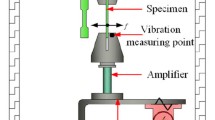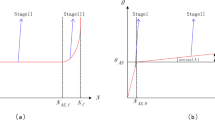Abstract
Using a complex limit stress diagram, we determine nondamaging conditions of vibration treatment of steel 20 welded joints, which ensure a decrease of residual stresses down to 0.5 of the yield strength of the material. We carry out comparative fatigue tests of specimens with high levels of residual stresses after vibration and thermal treatment and analyze the test results.
Similar content being viewed by others
Abbreviations
- σ R :
-
fatigue limit
- σ -1 :
-
fatigue strength under symmetrical cycling
- σ 0 :
-
fatigue strength under repeating cycling
- σ m :
-
mean stress
- σ a :
-
cycle stress amplitude
- σ min :
-
stress caused by static loading
- σ extmax :
-
maximum stress caused by external loading
- σ u ,σ Y ,σ cr :
-
ultimate strength, yield strength, and creep strength, respectively
- ɛ p :
-
residual strain
- σ ccrR :
-
cyclic creep strength
- σ ccr :
-
minimum cyclic creep strength
- σ ccrm :
-
mean stress at the minimum cyclic creep strength
- R ccr :
-
stress ratio at the minimum cyclic creep strength
- σ i res :
-
initial maximum value of residual stress
- σ k res :
-
residual stress after vibration treatment
References
P. I. Kudryavtsev,Welding-Induced Residual Stresses and Strength of Joints [in Russian], Mashinostroenie, Moscow (1964).
F. Z. Shpeyer and V. I. Panov, “Vibration treatment of large welded structures for reducing strains and susceptibility to cracking,”Svar. Proizv., No. 5, 13–15 (1983).
V. G. Polnov, O. G. Chikalidi, G. N. Ivanova, et al., “The influence of vibration treatment on mechanical properties of welded joints of low-carbon steel and 09G2S steel,”Svar. Proizv., No. 6, 20–21 (1991).
I. S. Min'kov, M. N. Mogilner and V. G. Polnov, “The influence of the vibration-loading treatment on dimensional stability of welded units,”Svar. Proizv., No. 2, 26–28 (1980).
L. Thompson,A Method of Removing Stresses in Components by Vibration and a Setup for This Purpose [Russian translation], UK Patent No. 1259556 (1969).
B. S. Shulginov and V. A. Degtyarev, “A method of reducing residual stresses in structures,”USSR Inventor's Certificate No. 1328119, Publ. no 07. 08. 87, Bull. No. 92 (1987).
V. A. Degtyarev, “The influence of the cycle stress ratio on fatigue and cyclic creep of low-alloy steels Part 2,”Probl. Prochn., No. 2, 27–31 (1991).
V. A. Degtyarev and V. I. Vlasenko, “Application of a complex limit-stress diagram for vibration treatment,”Tyazheloe Mashinostroenie, No. 8, 27–30 (1992).
V. A. Degtyarev, “A setup of DSO type for fatigue tests under repeated impact and harmonic loading with various cycle asymmetry,”Probl. Prochn., No. 10, 110–113 (1992).
M. E. Garf, I. I. Ishchenko, E. Ya. Filatov, et al., “A setup for high-temperature axial-loading fatigue testing of specimens,”Prikl. Mekh., No. 15, 94–100 (1974).
V. I. Trufyakov,Strength of Welded Joints under Variable Loads [in Russian], Naukova Dumka, Kiev (1990).
S. V. Grishakov and A. I. Kovalev,The use of the Barkhausen Effect for the Evaluation of Stresses and Damage in Ferromagnetic Materials [in Russian], Preprint, Institute for Problems of Strength, Academy of Sciences of the UkrSSR, Kiev (1988).
V. A. Degtyarev, “The influence of the cycle stress ratio on fatigue and cyclic creep of low-alloy steels. Part 1,”Probl. Prochn., No. 2, 24–27 (1991).
GOST 3248-81. Metals. Method of Creep Testing [in Russian], Introduced on 01. 07. 82.
S. V. Serensen, V. P. Kogayev and R. M. Shneiderovich,Load-Bearing Capacity and Strength Calculation for Engineering Components [in Russian], Mashinostroenie, Moscow (1975).
N. G. Visilovskii N. G. Pozhidaev, V. M. Demin, et al., “Problems of using vibration treatment instead of heat treatment,”Tyazheloe Mashinostroenie, No. 8, 20–22 (1992).
Additional information
Institute for Problems of Strength, National Academy of Sciences of Ukraine, Kiev, Ukraine. Translated from Problemy Prochnosti, No. 2, pp. 106–114, March–April, 1999.
Rights and permissions
About this article
Cite this article
Degtyarev, V.A. Estimation of the effect of vibration treatment on the life of low-carbon steel welded joints. Strength Mater 31, 185–190 (1999). https://doi.org/10.1007/BF02511108
Received:
Issue Date:
DOI: https://doi.org/10.1007/BF02511108




